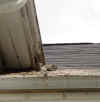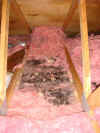Squirrel Removal FAQ
Frequently asked questions and information about squirrel removal
Squirrels in the Attic
What type of Squirrels are in my attic?
Our area is home to 2 types of attic-dwelling squirrels- flying squirrels and gray squirrels. Both species will generate a considerable amount of noise in ceilings and walls. As a general rule of thumb, noises at night are usually from flying squirrels and noises during the day (or at dawn and dusk) is from gray squirrels.
How many Squirrels could possibly reside in my attic?
It is common for us to find 1-5 gray squirrels residing in an attic. In the spring when the juvenile gray squirrels become mobile we often see 5-8 squirrels in attics. Flying squirrels are found in much greater numbers. Most flying squirrel infestations we see have between 6-12 flying squirrels. However it is not uncommon for us to find upwards of 25 flying squirrels in an attic. In February of 2005 we removed 41 flying squirrels from an 1100 square foot attic in Medfield Ma.
Will mothballs make them leave?
Using mothballs in an attempt to deter squirrels is a bad idea for several reasons. In order for a "mothball treatment" to be effective you would have to cover all areas of your attic with them. Once this is done the mothballs will give off heavy fumes and may or may not discourage the resident squirrels. These fumes will often seep down into the living-space of the house and produce an unbearable stench. Mothball fumes produce headaches, sore throats and long-term exposure can even cause poisoning. Another thing to consider is that once you spread a couple hundred mothballs through your attic they will roll into cracks, crevices and other voids and it is impossible to retrieve them. Mothballs are not made to deter squirrels or any other animals for that matter.
Juvenile Squirrels | What do we do if there are baby squirrels in the attic?
Most female squirrels will give birth to one litter of young each year. This happens in the spring during the months of March, April, May and June. Certain precautions must be taken to ensure that juvenile squirrels are not left behind in an attic. During this time of year we work with squirrels every single day. We have a very good sense as to what stages the juvenile squirrels are in at that time. We also know quite a few tricks to removing them safely.
*Some female squirrels will also give birth to a second litter of young in the early fall (usually September).*
I see the hole that the squirrels are using, should I block it up?
No. If you block up a squirrel hole they will either chew around the patch material, creating even more damage, or if you do a good job of the sealing the hole they will be trapped in your attic and will chew their way down into your living room. Even worse they could die in your attic or inside the walls of your house. This creates a very difficult situation as it is much easier to remove a live squirrel the right way then to remove a decaying squirrel carcass from a wall. It is also much more expensive to remove dead squirrels than it is to remove live ones.
We have a safe and effective process that we use for removing squirrels from house, which is explained on our squirrel removal page
Squirrel in the Chimney | A squirrel has fallen into our fireplace, what should we do?
Call a professional to remove it. A squirrel in a fireplace is a trapped animal, it is there because it is stuck and cannot get out. Believe me when I tell you that it doesn't WANT to be inside your fireplace. No amount of loud music, mothballs or even lighting a fire is going to make it leave.
Squirrels in my backyard | Squirrels are all over my backyard and eating from my bird feeders. Can I trap them and release them somewhere else?
Trapping and relocating squirrels is not a good solution to this problem. First of all its illegal. The state prohibits the relocation of any animal from one place to another. Secondly, this practice is not effective and doesn't solve anything. In any given neighborhood there are dozens and dozens of squirrels. Are you going to trap and relocate every squirrel in your neighborhood? Instead try buying a squirrel proof bird feeder or placing the feeders in an area where the squirrels can't get to them.
Squirrel Prevention | How do I prevent a squirrel problem?
The best thing that homeowners can do to prevent squirrel problems is to:
Cap your chimney. This will prevent squirrels from falling into your chimney or even making a nest.
Trim your trees. Keep all tree branches trimmed at least 10 feet from the roof of your house. This will prevent squirrels from getting onto your roof and creating damage.
Squirrel Damage | What type of damage do squirrels create in an attic?
Gray squirrels are famous for chewing wiring. 95% of the time you hear about a house fire because of squirrels it is gray squirrels that are to blame. It is usually severe gray squirrels infestation where we see chewed wiring. Both flying and gray squirrels will do significant damage to a home's insulation. They will tear it apart for nesting material and also urinate/defecate all over it. In severe (and often neglected) infestations we see urine staining on exterior walls of house, paint damage and even staining from urine on interior ceilings.
Visit our Squirrel Removal page for more information on our services.







